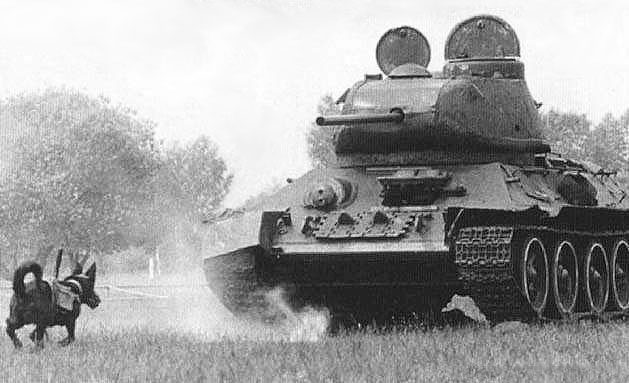Dogs have been used in war since ancient times., and the Soviet Union had approved its use for the military during a series of less destructive tasks since 1924. Was not up 1930, However, that the idea of use to the dogs as mobile mines gained interest, and with it the explosive devices adapted to our four-legged friends. In 1935, the Red Army unveiled its first anti-tank division formed by dogs.
The dogs were trained to carry boxes or bags of explosives subject by means of a harness on his back. Were initially instructed them to pursue a static goal, The idea was to pull a rope, with the help of his teeth, in order to rid the lethal cargo. The explosive charge was triggered by a timer, so the dog's life depended on the ability and speed it had to pull the cord in time..
Dogs, en su mayoría callejeros, they could not dominate the task, and what is more, a menudo corrían de regreso hacia sus entrenadores con la bomba sin entregar. These errors in the battle would have been catastrophic to causing a boomerang effect and placing its Division into a countdown.
As a result of this setback, the idea has been simplified. The dogs were trained to find any enemy tank, detonating bombs in contact with its target. A cada perro se le enseñó a bucear bajo el tanque de manera que una palanca de madera que sobresalía de sus paquetes se rompía al chocar con los bajos de los carros, producing the detonation of explosives. Both the enemy and the unfortunate dog jumped into a thousand pieces.
El adiestramiento consistía en mantener a los perros en ayunas durante varios días then give them to eat under the tanks idling. In this way they related the armoured with food. The ground floor of the tanks are the part with less armour, so the explosion of an explosive charge in that area was lethal for his crew.
When the conflict intensified in the eastern front, so did the use of dogs, and in the summer of 1941, 30 integrantes del depósito canino anti-tanques habían llegado a la primera línea del frente. But, ¿Qué efectividad tenían estos obligados Kamikazes, en su mayoría pastores alsacianos, in the battle? Not many.
Los perros de inmediato buscaron el conocido olor que desprendían los motores diésel de los tanques soviéticos en lugar de el olor de la gasolina de sus homólogos alemanes, They also refused to dive into the tanks were on the move and is frightened by the unknown noise of firearms. Los perros que corrían, persistently, next to the German tanks they were shot, While the they retreating to the trenches often they detonated the load, killing and injuring the Soviet soldiers.
Los pocos perros que no morían en acto de servicio tuvieron que ser sacrificados, so hopeless people coaches refused to train new ones.
The first group of 30 dogs, only four managed to detonate their bombs near the German tanks, While six exploded in his return to the Soviet trenches and three were shot. Some lucky ones were taken by the German army, Once freed of his load.
In part, Thanks to the capture of these dogs, the German army soon learned of this Soviet practice and took action against what, However saw this as a program desperately ineffective, giving orders to shoot the dogs you will find at the sight.
Los perros-mina tenía éxitos ocasionales – in the battle of Kursk, for example, When 16 dogs exploited 12 tanques alemanes que se habían roto cerca de las líneas soviéticas, and close to the airport of Stalingrad , where 13 tanks were destroyed -, pero estos éxitos fueron pocos y distantes entre sí. In short – and despite the liar Russia propaganda – the dangerous drawbacks of the use of the Panzerabwehrhundethey were more than advantages, and the use of this cruel practice declined rapidly after 1942.
It was, However, later, to resurface in other conflicts, including the fight between the Viet Minh in Indochina in the years 1940 y sin éxito entre los insurgentes iraquíes en 2005.
 Perros militares soviéticos en la escuela de formación Óblast de Moscú en 1931 – Photo: Wikipedia
Perros militares soviéticos en la escuela de formación Óblast de Moscú en 1931 – Photo: Wikipedia Parade in red square, Moscú, 1938 – wilkipedia
Parade in red square, Moscú, 1938 – wilkipedia Russian soldier with perro-bomba – logovo
Russian soldier with perro-bomba – logovo Russian soldiers with Alsace pastors – logovo
Russian soldiers with Alsace pastors – logovo Soldiers of the SS Panzergrenadier Division advance in the battle of Kursk – Wikipedia
Soldiers of the SS Panzergrenadier Division advance in the battle of Kursk – Wikipedia
Sources: 1, 2, 3






